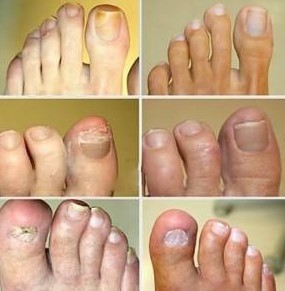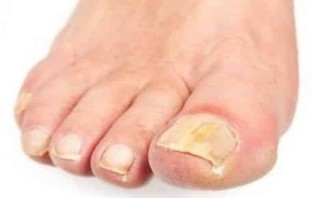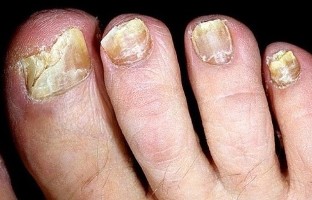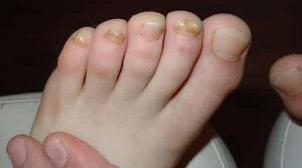Onychomycosis – disease, which destroys the nail plate. The fungus that eats the keratin – the basic construction of the nail. The infection penetrates into the extracellular space and begins its division. In the stages of the pathology is capable of affecting the skin stop, interdigital area of the heel.

The causes of nail fungus of the feet
Contracting onychomycosis fairly easily. The infection may be hiding on the beach, in the transports of the soul, the swimming pool. The high probability of catching a fungus of the infected by relatives or friends (use of common tools for the household).
There are a few key settings, which are capable of causing the penetration of the virus in the body of the man:
- the weakness of the immune system – the reduction of the forces protecting deferred due to infectious disease or inflammatory in nature;
- pathology of blood vessel (obstruction of veins) and the disorders of functioning of the internal organs (diabetes), which lead to problems with blood circulation in the lower limbs;
- minor damage to the skin on the soles of the feet (abrasion, cracks, corns, articles), as a result of wearing tight shoes;
- the ignorance of the diaper rash and intense sweating of the lower limbs;
- violation of the precautionary measures – fitting to another shoe, the visit of public places without slippers, and the neglect of the hygiene of the feet.
Types of nail fungus
Onychomycosis can cause several types of fungi. Dermatophytes, for example, manifested in the form of disorder of the nail. Observed the yellow spots on the edges or in the middle of the plate. In addition, there may longitudinal strip along the affected area.
The yeast fungus causes the deformation of the nail plate. It is highly diluted and begins to move away from its place, it becomes grayish. The metabolism of the traumatized cells deteriorates, on the nail shaft appear the furrows. In addition, adjacent to the epidermis appears a inflammation, swelling, redness is, we observe the disappearance of the nail of the epidermis.
Mold bacteria can damage the nail plate, if there are already diseases that cause eating disorders of the nails. In this case, also occurs a clouding of the plate, the change in color (from pale yellow and greenish to brown and even black).
To know the reason and agent of negative changes in the skin and nails, it is necessary to consult a specialist. Independent of the definition of the disease and its treatment without consulting your doctor can have serious consequences.
The stage of the disease

The nail fungus affects the healthy cells gradually. The disease has several stages of development, each characterized by its own events.
The first step of an onychomycosis (normotroficheskie) has no vivid manifestations. In most cases, it is silent. The first signs of the nail a little bit of tarnish, change color, develop cracks and yellow stains in the shape of circles or predilecta, appears tuberosity. Beginner the fungus can be accompanied by itching and a burning sensation. To correctly recognize the infection in the initial phase is difficult because the symptomatology is similar to other diseases (psoriasis, liver disease).
If time does not begin treatment, the disease moves to the next step hypertrophic. The nail becomes thicker, darker. The deformation of the plate, its collapse and destruction.
Launched the form of the disease of the nails is manifested by a strong thinning of the plate, which leads to further disintegration. Adjoining the skin turns blue, appears an unpleasant odor.
The symptoms
Onychomycosis most often affects the toe nails, are less likely to suffer from the hand. The disease begins with the thumb and the little finger (system the outside edge), and make striking of all the plates.
Determining the fungal infection will help the main symptoms of onychomycosis:
- the appearance of stripes or spots of whitish or greenish tint under the nails;
- a clouding of the plate, the change in color (from yellow to dark brown);
- redness is and peeling of the skin around the nail;
- the appearance of the roughness on the soles of the feet and between the toes;
- the formation of mold on the nails.
Types of fungal diseases of the nails
Onychomycosis agreed to classify the appearance of the affected areas. Because classifying the sign is like the air of nail fungus, it is distinguished by three types, depending on the clinic:
- atrophic, or animalisticheskih – in which the nail plate system significantly, to the extent of tearing away from the nail bed;
- hypertrophic, which has lost natural shine nail color changes (white or, on the contrary, darkens) and the structure (large thicker) with the appearance of a different kind of deformations and even collapse on the edges;
- normotroficheskie – view, characterized by the low level of corruption, in which the nail plate is not thickened, while remaining shiny and smooth, but all the same on the outside, is transformed through it, stains, scratches, and other visible changes natural transparency and colour.

In the foreign countries, there is another classification, according to which the mycosis of nails is divided into types depending on the specific position of the defeat:
- total pathogen on the object of the process to understand the whole of the nail plate;
- distal – the form of the defeat, containment, only on the free edge of the nail, occurring above the tip of the finger;
- proximal, which destroys the edge of the plate, coming out from under the nail of the roll (in front of the free edge of the nail!);
- the calf form of lesions affecting the sides of the nail.
What looks like pathology
Prevalent among the populations of the fungal diseases of the nails have external similarity with other dermatologic diseases negribkovoy of nature. Depending on the stage of the pathology, the nails begin to be painful, as they lose their natural radiance and transparency. From smooth and level, they economic thick and deformed, and covered with a different color (often a or off-white and yellow) patina. Of the soft tissues surrounding to destroy the parasite of the keratin layer is also involved in inflammatory reactions, swelling and izyaslavs.
If we consider the image of the destruction of the plate in the view of the dynamics of the disease, it can be divided into three stages:
- During the first phase of virtually no signs, light tarnish, spots or bands on the disk.
- On the t. n. expressed stage, quickly change the original, all the symptoms onychomycosis is obvious.
- Launched phase is the limit of the degeneration of the nail, can be supplemented by the advent of the smell of the decaying tissue.
The causes of the deformation of the nail
Mold d', yeast-like fungi and the fungi dermatophytes cause infectious diseases the nails (onychomycosis), which is manifested by similar symptoms. All kinds of nail fungus on the feet or hands can distort the nail plate, change the transparency, the brilliance of the colouring. The changes of the nail meet, not only during the onychomycosis, but in the case of injury chronic paronihii (inflammation of the nail of the roller), psoriasis, eczema of the brush, the dermatitis. Before you make a conclusion about fungal infection, you need to consider all possible options.
The symptoms of mycosis
There are a variety of classification of nail fungus, according to the type and of the event, they are very different in the signs and symptoms, so it is very important to determine its (psoriasis, eczema, stop tinea and dermatophytes that are very similar). The surface onychomycosis on fingers manifested almost immediately after the infection, the eye on the symptoms and signs of a fungal infection of the nails of the hands and feet:
- Thickened plate;
- Fragile, loose, or torn the concern is not only close to the edge, but on the whole surface;
- Deformed shape of the structure;
- The first step of the loss of luster and elasticity;
- If the nail blackened (does not count in the case where the person works regularly with coloring compounds or mechanical components);
- The nails sink deeper and deeper under the skin;
- Starts dizbakterioz, may be the common decline of the immunity, strength, sleepiness,
- Itching between the toes and on the foot, especially pronounced in children;
- The detachment of the nail, it is a very common phenomenon and almost the last stage before the complete loss of the nail, which is called onycholysis. You may feel pain in your fingers and discover a bit bad smell;
- The skin becomes dry, cracks, the eruption appears, it may even be the appearance of blood or ichor;
- Musty white or yellow circle under the nail, depending on the type of fungus, it can be clear, pale, with the outline of the edges and disorder in the structure.

Prior to the commencement of the action, the need to minimize the negative impact of the external environment, to eliminate the reasons for which became a fungus under the nails of the feet:
- Hot and humid environment ideal for the growth of micro-organisms, try all the time after a day of shipping shoes, wear socks only from natural materials, which provide the normal heat and ventilation;
- Cholera often occurs due to poor immunity, You can just walk barefoot on the floor, and catch an infection, to avoid this, take vitamins;
- Frequent intensification of the nails can be one of the causes of onychomycosis, limit the procedure up to 1 session per semester;
- The most difficult injected is a fungus called active spores. They penetrate into the gaps between nails and fingers, can be a bit of time in the phase of sleep, and after a sharp become. The more often they get in public places (swimming pools, showers, cabins, tanning salons), during the operation, another for shoes, etc
The common types of the fungal infection stop
There are a multitude of ways to be infected by a fungus feet, but perhaps it is only at a direct contact with the agent. The more often this occurs during the use of the other shoes or the violation of rules of personal hygiene. The fungus of the skin on the feet is usually manifested by the destruction of the layer of the dermis, which is reflected in the form of peeling. The lesions of the epidermis in this case is due to the fact that the infection penetrates in the deeper layers of the skin, destroying its structure.
The modern medicine has allocated the following options for fungal defeat of the judgment, each of which is distinguished by its symptoms and treatments:
- Fungus interdigital – the most common form, the way in which is manifested the disease. The symptom is usually localized in the interval between 3 and 4 fingers, at least between 4 and 5, it looks like a crack, covered with the white film. In the beams of the epidermis may be the selection of a certain amount of liquid, the peeling of the borders, as well as the onset of symptoms of diaper rash. Accompanied by signs between digits of the fungal infection of the feet can weakness itching. This fungus on the toes to the origin may take place completely without symptoms, but in the future, there is a significant change in the structure of the skin.
- The fungus squamous giperkineticeski are distinguishable from other species by a strong, desquamation and keratinization which affect the epidermis. Characteristic for people suffering from various types of dermatitis, mainly atopic. This is another type of illness, which we can clearly see, what are the fungi on the feet. The main characteristic of the disease – the onset of painful erythema, pink nodule on the exposed surface, which has clear limits. With a low itching, cracks on the feet, dryness, pain, discomfort, back coverage, and the defeat of the nail plate. Onychomycosis that usually accompanies this type of fungus, leads to flaking of nails;
- The fungus carrier vesicle, one of the most common of the infection, which strikes the epidermis of the feet. The name of the disease has received the teaching of the vesicle – bubbles with a liquid substance, which is then formed to erosion, hazardous for the infection. The main symptoms that characterize fungal vesicules: the appearance of blisters in diameter to 1 centimeter, and also the lowest of the itching;
- Cleared the fungus. The initial phase can produce a mild peeling of skin on feet, as well as the appearance of small cracks, outwardly, affecting only the top layer of the epidermis.
- The fungus disgidroticheskaya, the infection that occurs in medical practice, only 8% of patients infected by a fungus. Is localized mainly on the outsole and the arch of the foot, is manifested in the form of bubbles, gradually fall in a, after his break-up with the monitoring of the formation of the erosion of the broad type. The risk of late blight infection of this type is the possibility of acceding to a bacterial infection, because pathogens penetrate easily through the shape of the wound;
- The athlete's foot intertriginosny is not only yourself, but as an escort, scaly form of fungus of the feet. Manifests itself between the fingers stop, characterized by strong itching and a burning sensation, diaper rash and the appearance of erosions;
- Onychomycosis – still a common option of the defeat, which represents the nail fungus of the feet. Usually develops with the free edge of the plate, the initial stage is characterized by the appearance of yellow stains, after the progression of the disease with lamination and full passage of the nail. Often accompanies other forms of fungal infections;
- The fungus candidiasis vulvovaginal, also known as a yeast of the erosion, which is localized in the interdigital space. In this case, the fungus on the feet is like a concentration of the areas swollen or inflamed skin, which can be surrounded by the abscess of a small form.

























